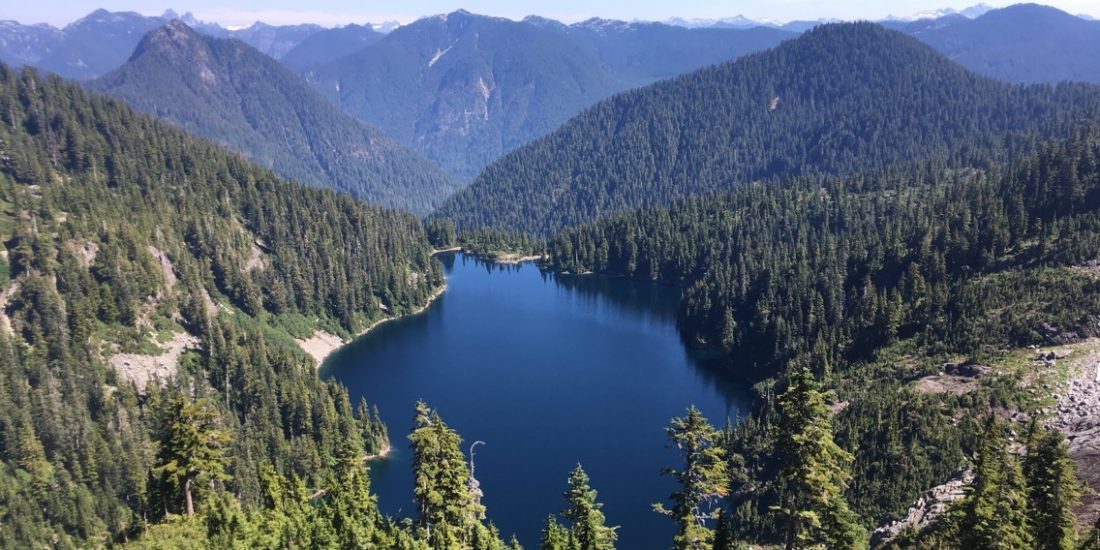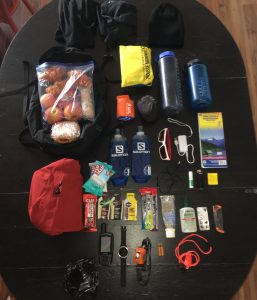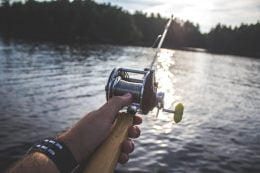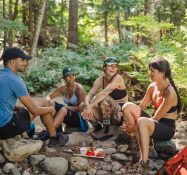What You Need in Your Pack for a Day Hike

The height of hiking season is upon us as summer in Vancouver winds to a close and fall begins, it’s the perfect time to head out on a day hike. Although Vancouver is still occasionally affected by the smoke from nearby forest fires, it’s gradually starting to clear. The trails are snow-free, and the weather is still warm and welcoming.
If you have the urge to push yourself physically while exploring the local trails, you need to be prepared for even the worst possible scenario. You can start by paying close attention to what you pack.
What I Pack for a Day Hike
I’ll use one of my most recent hiking adventures as an example of what to bring with you to be safe and prepared on the trail. This summer I embarked on a 27.5 km solo hike in Cypress Provincial Park, where I gained 2,300 metres in elevation and burned over 5,000 calories.

It’s always recommended that you hike with at least one other person, but preparing properly can ensure that you enjoy a safe hike, alone or with a group. Here’s what I had in my pack:
Food and Water
Since I knew that it was going to be a long and difficult day, I packed plenty of food that was high in calories, sugar and salt. I also brought extra food that would have lasted me another day should I have had to spend a night on the trail in an emergency.
I packed:
- 1 bagel with peanut butter and jam
- 2 large pepperoni sticks
- 1 large bar of chocolate
- 2 apples
- 1 peach
- 3 croissants
- 4 Clif Bars
- 3 Gu gel shots
- 3 Clif Gel Bloks
This amount of food equals about 3,700 calories, of which I ate about 2,220.
It’s also important to remember that this warm weather can also quickly tire and dehydrate your body. I needed to bring lots of water seeing as it was 30 degrees that day and there was no water I could purify on the trail. I brought five and a half litres of water and drunk nearly all of it.
Extra Clothing
Although it may seem odd to carry extra clothes on a scorching day in August, they could very easily come in handy. Firstly, the weather in the mountains can change on a dime. It can go from beautiful sunshine to torrential rain in a matter of minutes. Additionally, if I had to spend the night on the trail, temperatures can drop and become significantly colder. With this in mind, I packed a sturdy rain jacket that could double as a windbreaker, a toque, a thermal long-sleeve shirt and long underwear.
First Aid Kit
Any time you venture into the wilderness, this should be the first thing you put in your bag. Although you never want to have to use it, a first aid kit is useful, even if you’re treating the smallest of blisters. Some basic items you should keep in your first aid kit include:
- Sterile dressing (various sizes)
- Medical gloves
- Bandages
- Elastic bandage
- Triangular Bandage
- Duct tape
- Moleskin
- Antiseptic wipes
- Wound closure strips
Knowing how to use your first aid kit is vital. Taking a wilderness first aid course will make you far more comfortable when venturing out onto the trails.
Navigation and Communication
With a plethora of potentially confusing trail networks around Vancouver, it can be very easy to get lost. Carrying a navigation device that allows you to figure out where you are is extremely important. I carried a GPS with extra batteries that would allow me to pinpoint my exact location if I had veered off the trail. Since technology can’t always be relied upon, I also carried a map and compass and knew how to use them.
If I needed to contact authorities in an emergency, I carried my cell phone along with a portable charger. In remote mountainous areas, it’s hard to find reception from anywhere except the peaks of mountains. That’s why I also left a trip plan with a friend of mine that detailed my exact route, departure time and expected return time and I updated him when I could throughout the day. If he had not heard from me after the expected return time, he could safely assume that I had gotten injured in an area without reception and could contact the appropriate authorities.
Emergency Shelter
An emergency shelter should also be one of the first things you put in your bag. The most common item that you see in this category is the emergency thermal blanket, a blanket made from thin plastic sheeting that reflects heat, thereby keeping the wearer warm. For this hike, I carried an emergency bivvy sack, which I prefer over the blanket. An emergency bivvy acts as a thin, heat-reflective sleeping bag and keeps you warm and somewhat dry in an emergency. It’s lightweight and very portable and would keep you safe and comfortable until help arrived.
Signalling Device
This is another small thing that could make a huge difference in an emergency. I carried both a whistle and a small mirror with me in my pack. As opposed to shouting which takes far more energy, blowing on a whistle is more effective when rescuers are looking for you. Moreover, a mirror allows you to reflect the sunlight and alert passing aircraft. Naturally, this can only be done on sunny days.
Headlamp
As tempting as it may be to use the flashlight from your phone, it drains the battery very quickly and can’t be relied upon. A headlamp is useful and necessary during emergencies or when you start your hike early in the morning or are expecting night to fall before you finish. They’re easy to use, powerful and allow you to have both hands free. Therefore, I carried a sturdy headlamp along with four extra batteries.
Firestarter
Especially during autumn, winter or spring, it gets extremely cold overnight in the mountains all over British Columbia and Alberta. Accordingly, carrying a fire-starting kit is essential in keeping you warm if you must spend an unplanned night in the mountains.
A basic fire-starting kit should include: waterproof matches, a lighter, a knife and some flammable material like tinder or cotton wool, all contained in a waterproof case. However, many different fire-starting kits exist with varying materials. Since I knew that overnight temperatures wouldn’t likely drop anywhere below twelve degrees and it was going to stay very hot the days that followed, I only carried waterproof matches, a knife and a lighter in my bag.
Miscellaneous
These are just some extra things that I carry in my bag that I consider invaluable when venturing into remote places. Sun protection, especially on hot days, is very important to prevent dehydration and over-heating. Being that it was an especially hot day, I carried a hat, sunscreen and chapstick.
As I’m sure you’ve noticed if you’ve traveled into the mountains this summer, there are quite a few more bugs compared to previous years. Carrying bug spray can give you some relief from their relentless pestering. Finally, I also carried a waterproof cover for my backpack along with a couple garbage bags that can be used in emergencies or if you encounter or produce trash on the trail.
What Next?
Now you know exactly what to bring on your next hiking adventure in the mountains! So, what is there left to do? First, always thoroughly research the trail or route you intend to take. Find out if there’s water you can purify while out on the trail or if you must carry a day’s worth of water with you. Discover if there have been recent wildlife sightings or if there are ticks that are prevalent on the trail. Also, remember to check the weather and pack appropriate clothing.
Once you’ve decided on a route, create a trip plan detailing your departure time and location, your finishing time and location and the exact route you will take. Send this information to a close friend the night before. AdventureSmart has a free app to help make this easy. When you arrive at your finishing location or back into cell service, let this friend know that you’ve completed the hike and are safe. Ensure that your friend is aware that if they don’t hear from you by the estimated return time that they must call 911.
Although this might sound like an excessive amount of preparation, it could make all the difference should things go wrong while you’re in the mountains. Know yourself, know your limitations and ideally, always go with someone you trust.
Now what are you waiting for, get out there!
Ryan Village is from beautiful North Vancouver, and has worked as a zipline guide, a ski instructor and as a Vancouver area tour guide. He holds a diploma in Outdoor Recreation Management, Wilderness First Aid, and is a Yervana Local.





